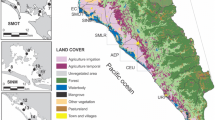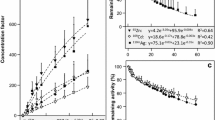Abstract
Purpose
The differential ability of apple snail tissues, endosymbionts, and eggs to bioaccumulate several metals (Sb, As, Ba, Br, Zn, Cr, Fe, Hg, Se, and U) was investigated.
Methods
Metal concentrations were determined by neutron activation analysis in several tissues, endosymbionts, and eggs from mature apple snails cultured in either drinking water or reconstituted water (prepared with American Society for Testing and Materials type I water).
Results
The highest bioconcentration factors (BCFs) in the midgut gland were found for Ba, Zn, Se, As, U, Br, and Hg (in decreasing order), while the highest in the kidney were for Ba, Br, and Hg. The foot showed the highest BCFs for Ba, Hg, Br, and Se (in decreasing order). Calcified tissues (uterus, shell) and eggs showed low BCFs, except for Ba. Both C corpuscles and gland tissue showed statistically higher BCFs than K corpuscles for Ba, Fe, U, Br, and Sb. The concentration of most of the studied elements was significantly lower in tissues and endosymbionts obtained from snails cultured in reconstituted water instead of drinking water. Snails cultured in reconstituted water and then exposed or not to Hg, As, and U (at the maximum contaminant level allowed by the US Environmental Protection Agency) also resulted in high levels accumulated in midgut gland, endosymbionts and kidney.
Conclusions
Our findings suggest that the midgut gland (and the symbionts contained therein), the kidney, and the foot of Pomacea canaliculata may be useful bioindicators of Hg, As and U pollution in freshwater bodies and that the unrestricted use of ampullariid snails as human and animal food must be considered with caution..


Similar content being viewed by others
References
Andrews EB (1965) The functional anatomy of the gut of the prosobranch gastropod Pomacea canaliculata and of some other pilids. J Zool 145:19–36
Andrews EB (1981) Osmoregulation and excretion in prosobranch gastropods part 2: structure in relation to function. J Mollus Stud 47:248–289
Andrews EB, Taylor PM (1990) Reabsorption of organic solutes in some marine and freswater prosobranch gastropods. J Mollus Stud 56:147–162
Baeyens W, Leemakers M, Papina T, Saprykin A, Brion N, Noyen J, De Gieter M, Elskens M, Goeyens L (2003) Bioconcentration and biomagnification of mercury and methylmercury in North Sea and Scheldt Estuary fish. Arch Environ Cont Tox 45:498–508
Baptista MS, Vasconcelos MT (2006) Cyanobacteria metal interactions: requirements, toxicity, and ecological implications. Crit Rev Microbiol 32:127–137
Bargagli R, Monaci F, Borghini F, Bravi F, Agnorelli C (2002) Mosses and lichens as biomonitors of trace metals. A comparison study on Hypnum cupressiforme and Parmelia caperata in a former mining district in Italy. Environ Pollut 116:279–287
Callil CT, Junk WJ (2001) Aquatic gastropods as mercury indicators in the Pantanal of Poconé Region (Mato Grosso, Brasil). Water Air Soil Pollut 125:319–330
Castro-Vazquez A, Albrecht EA, Vega IA, Koch E, Gamarra-Luques C (2002) Pigmented corpuscles in the midgut gland of Pomacea canaliculata and other Neotropical apple-snails (Prosobranchia, Ampullariidae): a possible symbiotic association. Biocell 26:101–109
Catalán NM, Fernandez SN, Winik BC (2002) Oviductal structure and provision of egg envelops in the apple snail Pomacea canaliculata (Gastropoda, Prosobranchia, Ampullariidae). Biocell 26:91–100
Catalán M, Dreon MS, Heras H, Pollero RJ, Fernandez SN, Winik B (2006) Pallial oviduct of Pomacea canaliculata (Gastropoda): ultrastructural studies of the parenchymal cellular types involved in the metabolism of perivitellins. Cell Tissue Res 324:523–533
Cavet JS, Borrelly GPM, Robinson NJ (2003) Zn, Cu and Co in Cyanobacteria: selective control of metal availability. FEMS Microbiol Rev 27:165–181
Cueto JA (2011) Pomacea canaliculata (Architaenioglossa, Ampullariidae): La hemolinfa y sus células. Thesis. Universidad Nacional de Cuyo, Argentina
Cueto JA, Giraud-Billoud M, Vega IA, Castro-Vazquez A (2011) Haemolymph plasma constituents of the invasive snail Pomacea canaliculata (Architaenioglossa, Ampullariidae) and their biological significance. Mollus Res 31:57–60
Deng PY, Shu WS, Lan CY, Liu W (2008) Metal contamination in the sediment, pondweed, and snails of a stream receiving effluent from a lead/zinc mine in southern China. Bull Environ Contam Toxicol 81:69–74
Devi CU, Rao KH, Shyamasundari K (1981) Observations on the histology and cytochemistry of the digestive gland in Pila virens (Lamarck)(Mollusca: Gastropoda). Proc Anim Sci 90:307–314
Diupotex-Chong ME, Cazzaniga NJ, Hernández-Santoyo A, Betancourt-Rule JM (2004) Karyotype description of Pomacea patula catemacensis (Caenogastropoda, Ampullariidae), with an assessment of the taxonomic status of Pomacea patula. Biocell 28:279–285
Estebenet A, Martín P (2002) Pomacea canaliculata (Gastropoda: Ampullariidae): life history traits and their plasticity. Biocell 26:83–89
Fiore MF, Moon DH, Trevors JT (1998) Metal resistance and accumulation in Cyanobacteria. Springer, Berlin
Fretter V, Graham A (1962) British prosobranch molluscs. Their functional anatomy and ecology. Ray Society, London
Goyal R, Seaward MRD (1981) Metal uptake in terricolous lichens. New Phytol 89:631–645
Haas JR, Bailey EH, Purvis OW (1998) Bioaccumulation of metals by lichens: uptake of aqueous uranium by Peltigera membranancea as a function of time and pH. Am Mineral 83:1494–1502
Halwart M (1994) The golden apple snail Pomacea canaliculata in Asian rice farming systems: present impact and future threat. Int J Pest Manage 40:199–206
Hayes KA, Joshi RC, Thiengo SC, Cowie RH (2008) Out of South America: multiple origins of non-native apple snails in Asia. Divers Distrib 14:701–712
Hoang TC, Rogevich EC, Rand GM, Frakes RA (2008) Copper uptake and depuration by juvenile and adult Florida apple snails (Pomacea paludosa). Ecotoxicology 17:605–615
Koch E, Vega IA, Albrecht EA, Ortega HH, Castro-Vazquez A (2006) A light and electron microscopic study of pigmented corpuscles in the midgut gland and feces of Pomacea canaliculata (Caenogastropoda: Ampullariidae). Veliger 48:17–25
Kolthoff IM, Elvin PJ (1986) Nuclear activation and radioisotopic methods of analysis. In: Kolthoff IM, Elvin PJ (eds) Treatise of analytical chemistry. Wiley, New York
Kurttio P, Komulainen H, Leino A, Salonen L, Auvinen A, Saha H (2005) Bone as a possible target of chemical toxicity of natural uranium in drinking water. Environ Health Perspect 113:68–72
Little C (1968) Aestivation and ionic regulation in two species of Pomacea (Gastropoda, Prosobranchia). J Exp Biol 48:569–585
Little C (1981) Osmoregulation and excretion in prosobranch gastropods. Part I: physiology and biochemistry. J Mollus Stud 47:221–247
Maltez HF, Tagle MV, Fernández de la Campa MR, Sanz-Medel A (2009) Metal-metallothioneins like proteins investigation by heteroatom-tagged proteomics in two different snails as possible sentinel organisms of metal contamination in freshwater ecosystems. Anal Chim Acta 650:234–240
Marigómez I, Soto M, Kortabitarte M (1996) Tissue-level biomarkers and biological effect of mercury on sentinel slugs, Arion ater. Arch Environ Contam Toxicol 31:54–62
Marigómez I, Soto M, Cajaraville MP, Angulo E, Giamberini L (2002) Cellular and subcellular distribution of metals in molluscs. Microsc Res Tech 56:358–392
Martín PR, Estebenet AL (2002) Interpopulation variation in life-history traits of Pomacea canaliculata (Gastropoda: Ampullariidae) in southwestern Buenos Aires Province, Argentina. Malacologia 44:153–164
Meenakshi VR (1955) The excretory spherioles in the digestive gland of Pila virens. J Anim Morphol Physiol (Bombay) 3:75–78
Nieboer E, Richardson DHS (1980) The replacement of the nondescript term ‘heavy metals’ by a biologically and chemically significant classification of metal ions. Environ Pollut B 1:3–26
Piyatiratitivorakul P, Ruangareerat S, Vajarasathira B (2006) Comparative toxicity of heavy metal compounds to the juvenile golden apple snail, Pomacea sp. Fresen Environ Bull 15:379–384
Rosenberg DM, Resh VH (1993) Freshwater biomonitoring and benthic macroinvertebrates. Chapman & Hall, New York
Sari A, Tuzen M, Uluözlü ÖD, Soylak M (2007) Biosorption of Pb (II) and Ni (II) from aqueous solution by lichen (Cladonia furcata) biomass. Biochem Eng J 37:151–158
Seuffert ME, Martín PR (2012) A lentic dweller in lotic habitats: the behavior of the invasive South American apple snail Pomacea canaliculata in flowing water. Aquat Ecol 46:129–142
Snyder NFR, Snyder HA (1969) A comparative study of mollusk predation by limpkins, Everglade kites, and boattailed grackles. Living Bird 8:177–223
Steinberg CEW, Geyer HJ, Kettrup AAF (1994) Evaluation of xenobiotic effects by ecological techniques. Chemosphere 28:357–374
Tamburi NE, Martín PR (2011) Effects of food availability on reproductive output, offspring quality and reproductive efficiency in the apple snail Pomacea canaliculata. Biol Invasion 13:2351–2360
Uluözlü OD, Sari A, Tuzen M, Soylak M (2008) Biosorption of Pb (II) and Cr (III) from aqueous solution by lichen (Parmelina tiliaceae) biomass. Bioresour Technol 99:2972–2980
Vega IA, Gamarra-Luques C, Koch E, Bussmann LE, Castro-Vazquez A (2005) A study of corpuscular DNA and midgut gland occupancy by putative symbiotic elements in Pomacea canaliculata (Caenogastropoda, Ampullariidae). Symbiosis 39:37–45
Vega IA, Damborenea MC, Gamarra-Luques C, Koch E, Cueto JA, Castro-Vazquez A (2006) Facultative and obligate symbiotic associations of Pomacea canaliculata (Caenogastropoda, Ampullariidae). Biocell 30:367–375
Vega IA, Giraud-Billoud M, Koch E, Gamarra-Luques C, Castro-Vazquez A (2007) Uric acid accumulation within intracellular crystalloid corpuscles of the midgut gland in Pomacea canaliculata (Caenogastropoda, Ampullariidae). Veliger 48:276–283
Wilbur KM, Saleuddin ASM (1983) Shell formation. In: Wilbur KM, Saleuddin ASM (eds) The mollusca 4, physiology part I. Academic, New York, pp 235–287
Yoshida K, Hoshikawa K, Wada T, Yusa Y (2009) Life cycle of the apple snail Pomacea canaliculata (Caenogastropoda: Ampullariidae) inhabiting Japanese paddy fields. Appl Entomol Zool 44:465–474
Acknowledgments
We thank Lic. Adriana M. Carrión for technical assistance. This work was supported by grants from the Universidad Nacional de Cuyo, Consejo Nacional de Investigaciones Científicas y Técnicas, and Fondo Nacional de Ciencia y Técnica (Argentina).
Author information
Authors and Affiliations
Corresponding author
Additional information
Responsible Editor: Stuart Simpson
Electronic supplementary material
Below is the link to the electronic supplementary material.
ESM 1
Bioconcentration factors (BCFs) by midgut gland, C and K corpuscles, and kidney in snails cultured from hatching to 4 months old in reconstituted water and then exposed for two additional months to either Hg, As, or U (DOC 53 kb)
ESM 2
Element concentrations (milligram per kilogram of dry mass) in different foods provided to apple snails in culture (mean ± SEM; N = 6, DOC 55 kb)
Rights and permissions
About this article
Cite this article
Vega, I.A., Arribére, M.A., Almonacid, A.V. et al. Apple snails and their endosymbionts bioconcentrate heavy metals and uranium from contaminated drinking water. Environ Sci Pollut Res 19, 3307–3316 (2012). https://doi.org/10.1007/s11356-012-0848-6
Received:
Accepted:
Published:
Issue Date:
DOI: https://doi.org/10.1007/s11356-012-0848-6




